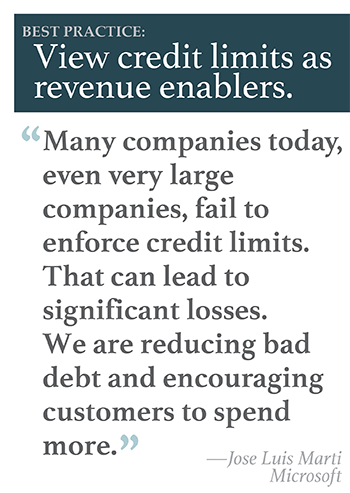
At Microsoft, advertising has become an increasingly importantsource of revenue over the past few years. “Our search revenueencompasses both Bing [the Microsoft search engine] and also therevenue generated through a number of syndication deals onplatforms which are powered by Bing,” explains Jose Luis Marti,director of Microsoft's Worldwide Online Credit Services (WOCS)treasury team. “On our platform, we provide both display and searchadvertising, and in both cases it tends to be customized based onour customers' and end users' preferences.
|“It's our job in the treasury team,” Marti continues, “to ensurethat the number of impressions and searches a customer purchasesdoes not exceed what they can afford to pay, which is determined bytheir credit limit. If we assign a credit limit of $100,000 toCompany X, then they should receive only $100,000 worth ofimpressions or searches. Once they reach that limit, they will notreceive any more advertising until they have made a payment or theysecure a higher credit limit.”
|When Microsoft first launched Bing, it engaged a leading Webservice provider to manage the entire sales and order-to-cashprocesses for its large and midsize search advertising customers.However, as Bing grew and its advertising revenue becameincreasingly important to the overall business, Microsoft saw astrategic advantage to bringing the full management of thisbusiness in-house.
|“As the Bing platform became more relevant in the marketplace,it began to face an increasing number of fraud attacks,” Martisays. “We are very risk-averse. Two years ago, we decided to endthe partnership with this leading Web service provider so that wecould take better control over the management of our business,which includes fraud and customer credit risk.” For this transitionto work, the WOCS team needed to develop a process that wouldenable them to effectively, and efficiently, manage credit limitsand impressions served for Microsoft's hundreds of thousands ofsearch advertising customers around the world.
|First, Marti and his team conducted a needs assessment,consulting approximately 80 stakeholders across engineering, sales,support, treasury, legal, and finance. They found some stakeholderswere concerned that more rigorous management of customer creditrisk would stymie sales. “It was crucial to make sure the projectwould not disrupt revenue in any way,” Marti says.
| The project team set three keygoals for the Credit Limit Enforcement (CLE) system it wasdeveloping: increase profit margins by reducing bad debtwrite-offs, improve financial risk management, and simplifyprocesses. To mitigate stakeholder concerns, they planned a phasedrollout of the system, starting with a controlled sample ofcustomers, then expanding to encompass more customers as theprocess proved successful.
The project team set three keygoals for the Credit Limit Enforcement (CLE) system it wasdeveloping: increase profit margins by reducing bad debtwrite-offs, improve financial risk management, and simplifyprocesses. To mitigate stakeholder concerns, they planned a phasedrollout of the system, starting with a controlled sample ofcustomers, then expanding to encompass more customers as theprocess proved successful.
Today, Microsoft's system establishes and enforces credit limitsfor all of the company's search advertising customers, automatingas many of those processes as possible. For every new customer,either the customer or the Microsoft account manager (if the dealis generating enough revenue to merit an account manager) completesa credit application, providing financial and contact information.The system supplements this information with data from otherMicrosoft divisions the customer has done business with, as well asdata from third parties such as external credit bureaus. Then thesystem applies analytics and machine learning capabilities to thecompiled information, to determine the financial stability of thecustomer and set a credit limit.
|“This all happens automatically in about 92 percent of cases,”Marti says. “The rest go for manual review, but because we havedramatically reduced the proportion requiring human intervention,we can usually assess the customer's creditworthiness within oneday. If the manual review reveals a credit concern, we will offerthe customer other payment options, such as prepayment, paymentwith a credit card, or perhaps a security deposit. We always giveprospective customers an option that will allow them to do businesswith Microsoft.”
|When the credit decision is made, the requestor—whether thecustomer or account manager—automatically receives an email withthat information. At that point, the customer is able to startscheduling search advertising on credit, for payment after thefact.
|From this point, the CLE system monitors the customer's spendingon an ongoing basis. If spending approaches the established creditlimit, the system may automatically reconsider that threshold. “Itwill take a number of factors into consideration,” Marti explains.“It will look at the customer's payment history with Microsoft andmay again pull in third-party data. It will also consider whenMicrosoft last performed a credit review of the customer and howlarge the last increase was.”
|The WOCS team has established rules around the amount andfrequency with which credit limits can increase. If the CLE systemdeems a customer worthy of a higher limit and the increase abidesby these rules, the system will automatically provide the customerwith additional credit. “It's similar to the way credit cardcompanies automatically increase credit limits,” Marti says. “Ourgoal is to help our customers spend more with Microsoft wheneverpossible.”
|If the CLE system determines that a customer's credit limitcannot be raised, the customer and Microsoft account manager willreceive email notifications as spending reaches 70 percent, 80percent, and then 90 percent of the credit limit. When spendinghits 100 percent of the credit limit, search advertising activitiesare automatically cut off—but they resume as soon as the customermakes a payment to bring spending back under the creditthreshold.
|Throughout these processes, the CLE system is monitoring alltransactions for fraud. Unexpected spikes or changes in searchadvertising usage result in emails to the salesperson and customer.The purpose of these communications is to receive assurance fromthe customer that the unusual behavior is legitimate.
|As a result of the CLE system, the Microsoft search advertisinggroup was able to proactively increase customers' credit limitssignificantly. “The business is growing faster than it otherwisewould have, because we are allowing customers to spend more,” Martisays. “If we didn't have the functionality to auto-increase creditlimits, the WOCS processes might be blocking good revenue. Our goalis to identify those cases which may represent a loss in thefuture.”
|At the same time, he adds, the system has dramatically improvedthe efficiency of credit and collections processes: “Now, eachcollections specialist can manage three to four times as manyaccounts as he or she could previously. Plus, the system educatescustomers and motivates them to pay faster. All in all, we'vereduced bad debt write-offs for Microsoft's search advertisingbusiness considerably year over year, and we are well belowindustry norms.”
|Selling the sales team on these processes initially took time,but Marti says it has been well worth the effort. “Many companiestoday, even very large companies, fail to enforce credit limits,”he says. “That can lead to significant losses in aconsumption-based business like this one, where spending can add upvery quickly. Not only are we reducing bad debt and encouragingcustomers to spend more, but the built-in fraud alerts, combinedwith the system's improved visibility into customer spending,enable us to recognize right away when we're the target of a fraudor when a customer is near insolvency. That has helped us achievemargins on our search advertising business that we believe are wellabove the average for the industry.”
|Thus, this project has established the WOCS team as purveyors ofnot just credit limit enablement, but true business enablement, andit has prepared Microsoft to continue growing its market share inthe search advertising sector.
|
See also:
And winners in our other categories of 2018 Alexander HamiltonAwards:
Complete your profile to continue reading and get FREE access to Treasury & Risk, part of your ALM digital membership.
Your access to unlimited Treasury & Risk content isn’t changing.
Once you are an ALM digital member, you’ll receive:
- Critical Treasury & Risk information including in-depth analysis of treasury and finance best practices, case studies with corporate innovators, informative newsletters, educational webcasts and videos, and resources from industry leaders.
- Exclusive discounts on ALM and Treasury & Risk events.
- Access to other award-winning ALM websites including PropertyCasualty360.com and Law.com.
*May exclude premium content
Already have an account? Sign In
© 2024 ALM Global, LLC, All Rights Reserved. Request academic re-use from www.copyright.com. All other uses, submit a request to [email protected]. For more information visit Asset & Logo Licensing.







